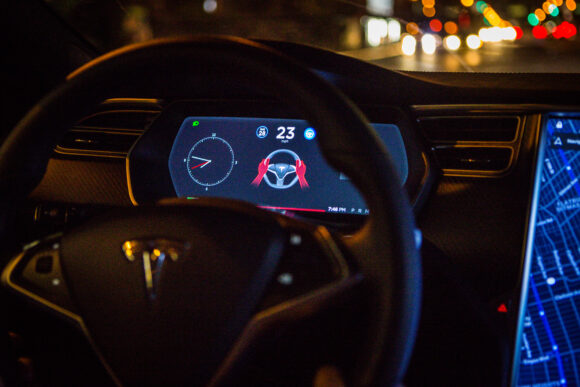
Tesla Inc. was told by a jury to pay $243 million over a 2019 Autopilot crash in Florida that killed a young woman and seriously injured her boyfriend, the first significant court loss for the automaker in litigation related to its driver-assistance technology.
A jury in Miami federal court found Friday that Tesla was 33% to blame for the collision. A Tesla Model S ran a stop sign at a T intersection in the Florida Keys and rammed into the couple’s parked Chevrolet Tahoe while they were standing next to it.
Related: Tesla to Fight California’s Claim It Overhypes Autopilot
Jurors issued their verdict after less than a day of deliberations following a three-week trial. The jury determined that the Tesla S driver was 67% responsible for the crash and that Tesla should pay $42.5 million to compensate the victims for their losses. The panel also awarded $200 million in punitive damages against Tesla.
Tesla had argued the driver was entirely at fault because he was distracted when he dropped his mobile phone on the floorboard.
“Today’s verdict is wrong and only works to set back automotive safety and jeopardize Tesla’s and the entire industry’s efforts to develop and implement life-saving technology,” Tesla said in a statement. “We plan to appeal given the substantial errors of law and irregularities at trial.”
Related: Tesla Goes to Trial Over Fatal Autopilot Crash in Florida
The Miami suit is one of a handful of crash cases that have gone to trial and the verdict tarnishes Tesla’s near-perfect record in court. The electric-vehicle maker prevailed in two previous trials in California over Autopilot-related crashes and has struck confidential accords to resolve several cases that blamed defective technology for deadly accidents.
The verdict comes as Tesla Chief Executive Officer Elon Musk faces enormous investor pressure after the company’s stock has been battered, first by his close affiliation with President Donald Trump, and then by his dramatic falling out with the president.
Musk has staked Tesla’s future in part on autonomous driving as the company is launching a robotaxi business. But when Tesla recently announced disappointing second-quarter earnings, Musk warned that the company is in for a few “rough quarters” as incentives like the EV tax credit go away in the U.S.
At trial, the jury heard testimony from the driver of the Model S, family members of the woman who died, company engineers and various outside experts who discussed whether Autopilot played a role in the collision.
George McGee, the driver of the Model S, had engaged his vehicle’s driver-assistance system while traveling home from work. In the moments before the collision, data obtained from the vehicle showed that he had pressed the accelerator to 17 miles (27.4 kilometers) per hour over the posted speed limit, leading him to override the vehicle’s adaptive cruise control before he went off the road.
McGee testified that he had been on hold on with American Airlines trying to modify an upcoming flight. He said his phone fell and he was looking for it just before the crash. As his car left the road, McGee said he felt the texture of the road change under his tires and he remembered “jamming on the brakes.”
During questioning, he told jurors that he knew he was completely responsible for operating the car, but that he expected Autopilot to assist him in the event he made a mistake.
“In that case, I do feel like it failed me,” he said, according to a transcript of his testimony.
The family of Naibel Benavides Leon, the woman who was killed, reached a confidential settlement with McGee in 2021 in a separate lawsuit.
Lawyers for the estate of Benavides Leon and her boyfriend, Dillon Angulo, argued Tesla’s Autopilot encourages complacency and that the company and Musk have overstated the system’s capabilities, leading drivers to be overconfident in its abilities.
They also alleged that Tesla failed to add safeguards to ensure the software was only available on roadways where it was designed to be used and features to monitor the attentiveness of drivers.
“Today’s verdict represents justice for Naibel’s tragic death and Dillon’s lifelong injuries, holding Tesla and Musk accountable for propping up the company’s trillion-dollar valuation with self-driving hype at the expense of human lives,” Brett Schreiber, lead attorney for the crash victims, said in a statement.
Tesla, as it has in other cases, blamed driver error for the collision. Lawyers for the company argued repeatedly that McGee was an aggressive driver with a history of speeding, and that he took his eyes off the road and his hands off the wheel despite warnings in the owners’ manual that drivers must stay engaged.
The company has maintained there were no defects in its software and that Autopilot operated exactly as designed. Throughout the trial, Tesla defense attorney Joel Smith said no driver-assistance technology on the market in 2019 would have been able to prevent the crash.
The automotive industry categorizes automation systems in vehicles from Level 0 to 5, based on what features are available. Level 0 features simply pass on information to the driver, like sounding a warning when you’re driving out of a traffic lane. Tesla’s Autopilot is classified as Level 2 because it requires constant driver input and supervision.
The case is Benavides v. Tesla, 1:21-cv-21940, US District Court, Southern District of Florida (Miami).
Top photo: An instrument panel with the Tesla Motors Inc. 8.0 software update displays an autopilot disengagement warning inside a Model S P90D vehicle in the Brooklyn borough of New York, on Tuesday, Sept. 20, 2016. Photographer: Christopher Goodney/Bloomberg.
Copyright 2025 Bloomberg.
